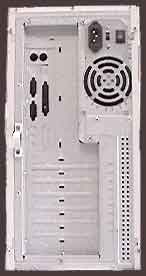The Case
The case is the box that houses the PC. All of the hardware, except for the peripherals, is housed inside the case. There are two common styles of cases: "desktop" and "tower." The desktop case usually sits under the monitor and is roughly the size of two or three shoe boxes side by side. The tower case stands upright on one end and is usually placed on the floor. Tower cases can be the same size as a desktop case but often range up much larger. Another, less common, case style is the "rack mount" case which slides in and out of an equipment rack.

All About the PC Case
The case, or enclosure, is the box that houses the PC's internal components. All of the hardware, except for the peripherals, is housed inside the case. There are two common styles of cases: "desktop" and "tower." The desktop case usually sits under the monitor and is roughly the size of two or three shoe boxes side by side. The tower case stands upright on one end and is usually placed on the floor. Tower cases can be the same size as a desktop case but can range up much larger. Another, less common, case style is the "rack mount" case which slides in and out of an equipment rack.
A case accommodates the motherboard which is fastened in with screws or snaps. Because there are different sizes, shapes and configurations of motherboards (referred to as "form factors"), you must make sure that the case you choose will accommodate the motherboard you intend to use. Refer to the section about motherboards for more information on form factors.
Cases are often sold with the power supply, so you should also consider the power requirements of your PC when choosing a case. More information about this can be found in the next section about power supplies.
Note that a PC should not be operated with it's case open. A good case is engineered to maximize cooling airflow while protecting the equipment from damage. If the case is not properly closed, the cooling operation of the case may be negated resulting in overheating. It will be exposed to more environmental pollutants such as dust and debris and the components are at greater risk of damage from accidental contact, bumps and spills.
As a convenience, some cases provide a feature that allows you access to the motherboard without unfastening it from the case. If a portion of the motherboard is inaccessible, especially the memory slots or CPU, look for this feature. It will be on the bottom side of the case, the motherboard may slide or fold out on a tray. Note however that the cables and possibly the installed cards may have to be disconnected to fully access the motherboard.
Opening the Case
Caution: please read our safety information.
Before opening the case, unplug the PC to avoid an electrical shock hazard. Exercise caution as there are sharp edges on a PC and its components. Always wear a static electricity discharge strap and attach the lead to the metal frame of the case, when working with your PC's components to avoid damaging your PC. Note that some manufacturers will void your PC's warranty if you open the case.
- Unplug the PC.
- While not strictly necessary, it is generally advisable to disconnect all of the wires from the back of the PC.
- Remove the screws or unfasten whatever secures the cover in place.
- Remove the shell or panel.
The method to open a case varies and it is not always obvious how it is done. A large percentage of cases have the screws on the back, along the perimeter. A plastic cover plate may have to be removed first. It is held in place with snaps and removed by gently tugging a corner. After removing the screws, a "U" shaped shell or a single panel will slide back and off of a tower case or forward (and possibly up) off of a desktop case.

Other designs include a case with the fasteners on the front, behind a removable plastic face plate or toolless designs that use a thumbscrew, sliding lock or simple friction to secure the cover in place. Look for screws along the perimeter of the case or devices that resemble a latch. You may have to do some detective work to figure out how to open your particular case.
When you put the cover back on, note any guide rails or alignment guides that must be matched for the cover to fit securely. Also, be careful not to snag any wires, which can easily be sliced by the case.
Related Video:

The chassis refers to the rigid framework onto which the motherboard, memory, disk drives, and other equipment are mounted.It protects all of the vital internal equipment from dust, moisture, and tampering. Thanks for sharing this useful information.
ReplyDelete
ReplyDeletenice blog..
Best wireless router